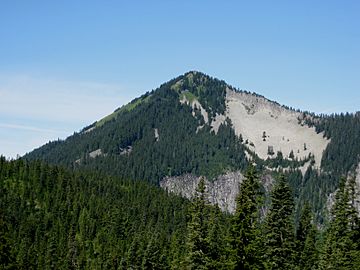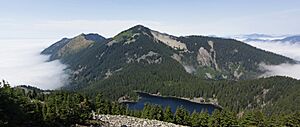Mount Defiance (Washington) facts for kids
Quick facts for kids Mount Defiance |
|
|---|---|

Mount Defiance, east aspect
|
|
| Highest point | |
| Elevation | 5,584 ft (1,702 m) |
| Prominence | 1,424 ft (434 m) |
| Isolation | 4.06 mi (6.53 km) |
| Parent peak | Granite Mountain (5,633 ft) |
| Geography | |
| Location | King County, Washington state, U.S. |
| Parent range | Cascade Range |
| Topo map | USGS Bandera |
| Climbing | |
| Easiest route | Hiking trail |
Mount Defiance is a mountain in King County, Washington. It stands 5,584-foot (1,702-metre) tall. This peak is part of the Cascade Range and is found inside the Alpine Lakes Wilderness.
Mount Defiance is about 6.5 mi (10.5 km) west of Snoqualmie Pass. It sits on land managed by the Mount Baker-Snoqualmie National Forest. Rain and melting snow from the mountain flow into streams that feed the Snoqualmie River. The closest taller mountain is Granite Mountain. It is 3.96 mi (6.37 km) to the east-southeast. Bandera Mountain is 1.85 mi (2.98 km) to the southeast. You can reach Mount Defiance by hiking trails. Popular starting points include the Ira Spring, Talapus Lake, or Pratt Lake trailheads.
Contents
Mountain Weather
Mount Defiance is in a "marine west coast" climate zone. This means it gets a lot of moisture from the Pacific Ocean. Most weather systems move from the Pacific Ocean northeast towards the Cascade Range.
How Mountains Affect Weather
When these weather systems hit the tall Cascade Mountains, they are forced to rise. As the air goes up, it cools down. This causes the moisture in the air to turn into rain or snow. This process is called Orographic lift. Because of this, the west side of the Cascades gets a lot of rain and snow. Winter months see especially heavy snowfall.
Seasonal Weather Patterns
During winter, the weather is often cloudy. But in summer, high-pressure systems over the Pacific Ocean become stronger. This often leads to clear skies with little or no clouds. The moisture from the ocean makes the snow wet and heavy. This can create a high risk of avalanches, which are dangerous slides of snow down a mountain.
Mountain Formation
The Alpine Lakes Wilderness has some of the most rugged land in the Cascade Range. You can see jagged peaks, sharp ridges, and deep valleys carved by glaciers. There are also many granite rock walls. Over 700 mountain lakes dot the landscape.
Geological History
Long ago, huge geological events shaped this area. These events created the varied landscape and big changes in elevation. These elevation changes also lead to different climates. This creates different ecoregions, which are areas with unique plants and animals. The land here ranges from about 1,000 feet (300 m) in lower areas to over 9,000 feet (2,700 m) on Mount Stuart.
The Cascade Mountains began forming millions of years ago. This was during a time called the late Eocene Epoch. The North American Plate was slowly moving over the Pacific Plate. This movement caused many periods of volcanic activity. Also, small pieces of the Earth's crust, called terranes, helped form the North Cascades. This happened about 50 million years ago.
Impact of Glaciers
During the Pleistocene period, which started over two million years ago, glaciers repeatedly covered and uncovered the land. As they moved, they scraped away rock and left behind debris. The last glaciers in the Alpine Lakes area started to melt and retreat about 14,000 years ago. By 10,000 years ago, they had moved north of the Canada–US border.
The "U"-shaped valleys you see today were formed by these glaciers. The combination of land being pushed up (called uplift) and cracks forming in the Earth's crust (called faulting) along with glaciation has created the tall peaks and deep valleys of the Alpine Lakes Wilderness.




